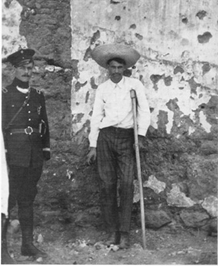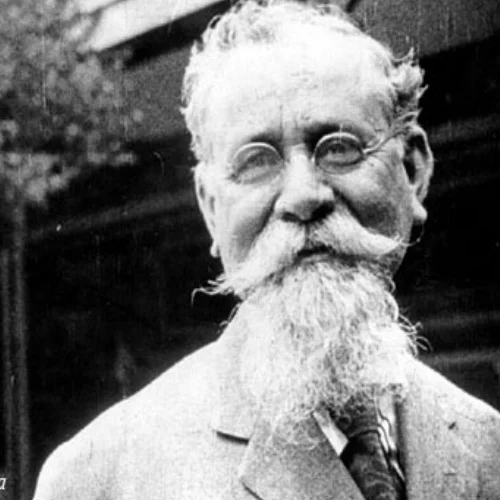Enrile arrived in New York from Havana around December 19th. It is difficult to determine exactly who sent him. There was a large exile community in Cuba at the time. Pancho Villa’s wife and brother, Hipólito, settled there after the collapse of the Division of the North in mid-December 1915. Felix Díaz, who had operated out of Havana before he moved to New York, also had a large contingent of supporters there. In addition, at the time former president of Mexico Francisco León De La Barra lived at the Hotel Astor in New York, so did Felix Sommerfeld and Heinrich Albert. Enrile himself claimed to German authorities that he represented the factions of De La Barra, Felix Díaz, Zapata, and Villa.
Although historians have dismissed his claims as ludicrous, these factions all had a common enemy in Carranza, and a common conviction that the First Chief had sold out Mexico to the United States. Both Villa and Zapata expected a military showdown with the United States within a short time. B.I. agents along the border who interviewed a Villista commander in April 1916 confirmed the development, “With the death of Orozco [in the summer of 1915] and Huerta [in January 1916] there has been a fusion of parties recognizing as leader Felix Díaz who, it is said, put himself in accord with Zapata… To invade American territory, to murder American citizens, burn American cities and cause all the possible depredations in American territory in order to bring a conflict with this nation [U.S.].”
The U.S. government had hired one of Villa’s secretaries, Dario Silva, in the fall of 1915. Silva reported to the Bureau of Investigations under deep cover, using the codename, “Avlis,” and thoroughly documented the fact that the Catholic Church (who supported Felix Díaz, as well) “offered Villa three hundred thousand dollars for protection about September, 1915, and that they would continue to support him if he would take the side of the church.” It seems that money did indeed flow, as B.I. Agent Blanford reported from Los Angeles on March 22nd 1916. The B.I. had discovered a retired U.S. army captain in Monrovia, California who held $55,000 ($1.1 million in today’s value) for Villa. The source of the money remained obscure with the captain making the unrealistic claim that Villa had brought him the money personally.
There was also the suspicion that the German government was financing Villa in his attempt to engage the U.S. in a war. A special agent of the B.I. in Pittsburg sent a letter to B.I. Chief A. Bruce Bielaski on April 12th 1916, with the information from a Wall Street investor that Hans Tauscher had told him about a payment of $320,000 to Villa. This roughly matched the suspected financial support from the Catholic Church. Was the “Catholic Church” a cover and conduit for the German government? Was this the same money?
Enrile, equipped with $1,000 in travel money from Felix Díaz, returned to Havana before shipping out to Europe. He likely conferred with members of the exile community there, which in the meantime, also included Hipólito Villa. Enrile traveled with the Mexico City lawyer Humberto Yslas to Spain on January 20th. Coincidentally, rumors abounded in New York and Havana that Villa had reached some sort of agreement with Felix Díaz.
George Carothers, the State Department envoy detailed to Villa until the Carranza recognition in October, wrote on March 3rd 1916, one week before the Columbus attack, “From very reliable source am informed that Villa has complete understanding with Felix Díaz, this understanding was reached last December [coinciding with Enrile’s conferences in New York] and my information comes from person who saw letter from Villa to Díaz accepting condition. I anticipate renewed Villa activity in very near future.” It seems plausible that Sommerfeld was Carothers’ “reliable” source and had indeed brought about the understanding between Díaz and Villa. Carothers’ ominous expectation of “Villa activity in very near future” reflected the general mindset among people familiar with developments in Mexico.
The Enrile delegation went to Santander, Spain. Enrile met with the German ambassador, Maximilian Prince Ratibor, showed him a letter of introduction from Franz von Papen, and asked for permission to continue to Germany. Historians have taken Ambassador Ratibor’s cool reception as an indication that Enrile’s mission had no import. However, as members of the Secret War Council in New York could attest to, the Imperial Foreign Service was diametrically opposed to provoking an American entry into the war. Felix Díaz agents had approached Ambassador Count Bernstorff with similar proposals in July 1915. According to the ambassador, “the group gathered around Felix Díaz is putting itself at our disposal should there be a war between the United States and Germany [as a result of the Lusitania sinking]… This issue is clearly highly sensitive, and I therefore told the man that a war between the United States and Germany appears out of the question to me.” Despite his misgivings, he sent the Mexican envoy to von Papen. This establishes a clear relationship between von Papen and the Díaz faction in line with the Enrile mission as early as the summer of 1915, when the Sommerfeld-Dernburg proposal had been adopted as military strategy. Opposing the Foreign Service, the German military did not fear an American provocation as long as distractions, domestic or along the Mexican border, could be created. Thus, it is not surprising that Ambassadors Ratibor and Bernstorff, as well as their superiors in Berlin, stymied the Mexicans’ efforts. After some back and forth, von Papen’s letter of introduction and possible confirmation by the military attaché that Enrile was legitimate, the Mexican delegation finally continued on to Berlin via Switzerland.
The proposal Enrile submitted on behalf of the “National Party” of Mexico “whose Vice-president I am” completely matched the information of American Bureau of Investigations agents who had interviewed a Villa commander earlier:
"The main proposal which I want to submit to the imperial government are the following:
Mexico needs weapons and munitions in order to defeat the reign of terror of the Carranza administration, as well as enough capital to recreate the old federal army. In addition the country needs the support of a large power such as Germany to resist the United States. In return we offer:
1) Installation of Mexican policies completely supportive of German policy, which is aimed against the interests of the United States.
2) Granting of concessions to Germany of railroads, petroleum, mines, and commerce.
3) Expulsion of American capital from the country through legal measures [i.e. expropriation].
4) Creation of an army strong enough to attack the United States in a for Germany and Mexico favorable moment.
5) Support of a separatist movement that already exists in several southern states of the United States: namely Texas, Arizona, New Mexico and the south of upper [U.S.] California.
6) Creation and support of a political race revolution in Cuba, Puertorico [sic], and Haiti.
7) Financial guarantees to Germany for weapons and munition in a for Germany agreeable form. The total sum, partly in cash, partly in weapons, munitions, and other war materials needed for an invasion of the United States amounts to 300 Million marks.
… any questions to be directed at Captain von Papen…"
Enrile laid out the rational for using Mexico to prevent the United States from entering the battlefields of Europe in another, more elaborate memorandum submitted to Count Montgelas of the Foreign Office (received there on May 15th 1916). The first paragraphs recounted the likelihood of an eventual war between Germany and the United States as a result of the lopsided neutrality policy to the detriment of the Central Powers. Mexico was herself involved in a
"… heroic and only because of her financial weakness desperate fight against the assaults of North America… A continuation of the conflict between Mexico and the United States [since the attack on Columbus] seem inevitable; Germany will be able to preserve the peace with the United States so long as the latter is fully occupied with the Mexican differences. Thus it could be achieved that:
a) The United States will be weakened enough, to become ineffectual for further [military] excursions.
b) The current manufacturing of weapons and munitions will end as a result of the United States requiring the same for herself [note the exact same argument in the Dernburg-Sommerfeld proposal from May 1915, proposing to create an American military intervention].
c) Mexico can save her existence as a result of the thus received support to defend herself.
Should it come to a war between the United States anyway, the support of a Mexican army easily expanding to 200,000 men could help bring the defeat of the United States on American soil along a 2,000 kilometer long border…
Signed Gonzalo C. Enrile, Colonel."
Considering the rationale of the Enrile memorandum, Villa did not just attack the United States in a quixotic, one-time effort. The alienated Mexican exile community, with Villa leading the effort, believed that a military intervention into the United States would create a boon of German support. Enrile’s proposal shows that, in his desperation, Villa clearly had aligned himself with factions of the old elite, especially that of Felix Díaz. Thus, Enrile’s claims of representing diverse factions such as Villa, Zapata, Díaz, and De La Barra, which hosts of analyses ridiculed, was true. The suspected existence of a secret agreement between Carranza and the Wilson administration, whether in writing or not, promoted the existential fear among Mexican exiles and Villa that only a confrontation with the United States could either sever the friendly relations of the U.S. with Carranza, or rally the majority of Mexicans behind a defender of the homeland in the persons of Pancho Villa or Felix Díaz.
The timing of the document, namely that it had clearly been drafted and agreed upon before Santa Ysabel and Columbus, is crucial. Thus, Villa’s attack on Columbus on March 9, 1916, was the beginning salvo of a much larger campaign that he was to undertake with the agreement and support of the other factions opposed to Carranza. Indeed, Villista incursions into the United States, small shoot-outs, and wholesale raids occurred several times between January and June 1916.
































